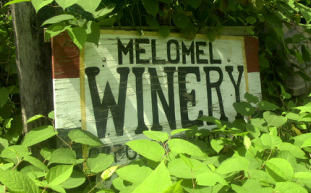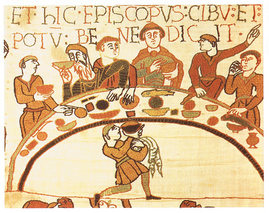About Us
History

Located in southwestern Pennsylvania, we officially opened our winery on January 1st, 2008. The story really began though with Dr. Ferenc "Frank" Androczi and his Little Hungary Farm Winery. Using knowledge and experience he gained in his home land, Frank planted a vineyard and started keeping bees in Buchkhannon, WV. He began making a unique type of wine branded as "Melomel" consisting of honey, grapes, apples, and pears. In 1994, after tasting Melomel and hearing about the old man, Leigh Shields volunteered to help him.
Working over several seasons provided an opportunity to see the methods used by an old-fashioned European type winery. No stainless steel tanks, chemical stockpile, or sophisticated bottling line. Just oak barrels, the natural ingredients, and a manual corker. The volunteering continued until 2001 when Frank suffered a stroke and could no longer work. Without any known relatives or formal apprentices, it seemed that Melomel might disappear for good. Frank didn't want this to happen and urged us to keep making it. Based on the same formula and process, we experimented and were extremely satisfied with the result. In fact, we've expanded upon the original red, white, and rose Melomel blends to create many distinct varieties.
Working over several seasons provided an opportunity to see the methods used by an old-fashioned European type winery. No stainless steel tanks, chemical stockpile, or sophisticated bottling line. Just oak barrels, the natural ingredients, and a manual corker. The volunteering continued until 2001 when Frank suffered a stroke and could no longer work. Without any known relatives or formal apprentices, it seemed that Melomel might disappear for good. Frank didn't want this to happen and urged us to keep making it. Based on the same formula and process, we experimented and were extremely satisfied with the result. In fact, we've expanded upon the original red, white, and rose Melomel blends to create many distinct varieties.
Interview with Frank Androczi
This is footage of Dr. Frank Androczi from 1992 talking about his Melomels.
It gives you an idea of what an interesting character he was.
Property of Brushy Mountain Bee Farm
It gives you an idea of what an interesting character he was.
Property of Brushy Mountain Bee Farm
Process

We've decided to stick with tradition and use "Melomel" as a proper name for referring to all of our wine made with grapes and honey. In addition to this, a specific process is maintained across all varieties.
Both grape juice and honey are mixed together and placed in 53 gallon oak barrels previously used for Bourbon whiskey production. Fermentation is promoted with cultured yeast and largely finishes after a few weeks, leaving a 12%-14% alcohol content. The yeast then dies and falls out of solution but must be removed from contact with the fresh wine to prevent bitter taste changes. To accomplish this, the wine is transferred to an empty barrel and aged where more yeast and heavy proteins precipitate. The transfer can be done multiple times to clear the wine. Bottling takes place once the taste seems best after at least 2 years of aging.
An interesting aspect about our winemaking is the location. It's all performed in a greenhouse - the fermentation, aging, and bottling. After running out of cellar space for barrels, we had little choice but to use a greenhouse from our nursery business (Shields Herb & Flower Farm) temporarily. "Temporarily" lasted longer than expected and ended with some great Melomel that was even more unexpected. The story seems incredible considering the vast temperature range a greenhouse can experience from summer to winter, or even day to night, but this method has worked for Melomel ever since. Even the plants benefit from the experience. The alcoholic fermentation produces carbon dioxide, increasing plant metabolism and leading to superior growth in the fall. Hard to believe I realize, which is why you should come and take a look!
Both grape juice and honey are mixed together and placed in 53 gallon oak barrels previously used for Bourbon whiskey production. Fermentation is promoted with cultured yeast and largely finishes after a few weeks, leaving a 12%-14% alcohol content. The yeast then dies and falls out of solution but must be removed from contact with the fresh wine to prevent bitter taste changes. To accomplish this, the wine is transferred to an empty barrel and aged where more yeast and heavy proteins precipitate. The transfer can be done multiple times to clear the wine. Bottling takes place once the taste seems best after at least 2 years of aging.
An interesting aspect about our winemaking is the location. It's all performed in a greenhouse - the fermentation, aging, and bottling. After running out of cellar space for barrels, we had little choice but to use a greenhouse from our nursery business (Shields Herb & Flower Farm) temporarily. "Temporarily" lasted longer than expected and ended with some great Melomel that was even more unexpected. The story seems incredible considering the vast temperature range a greenhouse can experience from summer to winter, or even day to night, but this method has worked for Melomel ever since. Even the plants benefit from the experience. The alcoholic fermentation produces carbon dioxide, increasing plant metabolism and leading to superior growth in the fall. Hard to believe I realize, which is why you should come and take a look!
⇓Read more about our process...⇓
Demesne
From the owner:
"The term demesne in the winery name goes back, for me, many years. When I was young, growing up between Newark, NJ and New York City, I had the opportunity to see first hand large city produce, flower, fish, and meat markets. These city districts were bustling with the sustaining products for the city populations. They were a giant expansion of the old-fashioned European town centers where food stuffs could be gotten cheaply.
|
Here in Western Pennsylvania, the Strip District of Pittsburgh was the great distribution place for food products, and in other great cities like Chicago, San Francisco, Los Angeles etc., there were similar market areas. These markets were ethnic; Italian, Greek, Irish, Polish, and Arabic with their familiar or strange, easy or tongue-twisting names plastered above their shops. And commonly after their names was Demesne.
|
Today, demesne is translated as domain and is most often used as an Internet term. But in the old days, demesne was defined as 'those lands held by the Crown' at the time of William the Conqueror. Since those days 1000 years ago, use of the word has faded. But if you happen to go to a large city market center with the old brick buildings behind rejuvenated shops, you may see painted on the bricks, faded names of merchants in front of a paint-chipped Demesne."
|

